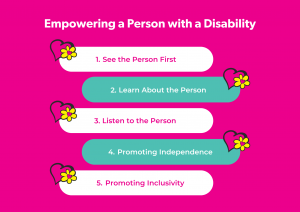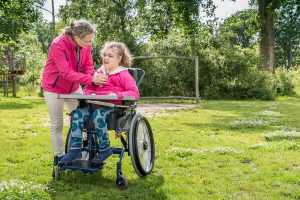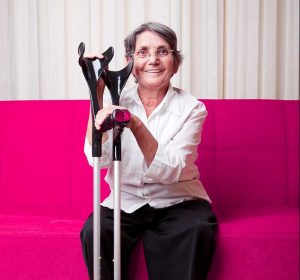5 Simple Ways to Empower a Person with a Disability
“One person can make a difference, and everyone should try.”
(John F. Kennedy)
5 Simple Ways to Empower a Person with a Disability
A recent study by Disabil Health J. found that even from 2020, people with a disability are still experiencing more loneliness, low perceived social support and social isolation at significantly higher rates than people without a disability.
To disrupt the stigma, build a collective understanding, and promote respect for people who have a disability, the United Nations created the International Day of Persons with Disabilities.
While this is a day to acknowledge, it is not enough to shed a more positive perception for people living with disabilities. As a society, it is up to us to drive the change, and shift outdated perceptions around people living with a disability.
One of the best ways we can contribute to positive change is to EMPOWER any person living with a disability to embracing their own sense of identity.
Whether it is an intellectual disability or a physical disability, here are 5 Simple Ways to Empower a Person with a Disability.


1. See the Person First, Not the Disability
If you haven’t spent time with someone who has a disability, it might be a very confronting experience. You might feel unsure about how to best approach them during your first interaction.
If you find yourself struggling with any interaction, try and put yourself in their shoes. How would you want to be treated?
It is important to remember that people living with a disability are just like us:
- They all have their own individual identity
- They feel the same emotions as we do
- They will have personal interests and hobbies
- They will experience romantic relationships
- They will have goals, dreams and desires
A person living with a disability does not want to be defined by their abilities, but by who they are as a person.
You don’t need to change your personal behaviour when interacting with someone who has a disability.
- Speak at your usual pace, volume and tone
- Use person-first language
- Relax and just be yourself


2. Ask Questions to Learn About the Person Behind the Disability
There will come a time when you might be unsure how to interact or even help someone living with a disability.
Rather than making preconceived judgements or assumptions on what a person with a disability might need, ask them what they want.
Take the time to discover more about the person behind the disability:
- What makes them smile?
- What they used to do that they can’t do anymore?
- What would make their day happier?
You may be surprised by what you discover when you take the time to ask questions. These insights into their personality can help you find a better way to work together and find the most creative, innovative and fun way to spend the day together.
The possibilities are endless!
3. Listen to the Person Behind the Disability
We hear it time and time again, listening and letting anyone use their own voice is crucial to ensure they are feeling empowered and confident within themselves.
When listening to a person with a disability, you can practice active listening techniques to let them know you are engaged in the conversation.
- Look at them directly
- Show them you are listening through non-verbal reactions (eg. nodding)
- Defer any judgements you might have
- Respond when it is appropriate
Communication is a two-way street, be patient and give the person the time to express their emotions, needs, dreams or desires.
Being a good listener also requires you to embrace your emotional intelligence.
When the opportunity comes for you to hold your next conversation with a person who is living with a disability, and you need to adapt your own communication style you can:
- Encourage them to elaborate
- Urge clarification if required
- Accept that we are all vulnerable
- Separate the criticisms you might hold (even if they are unintentional)


4. Encourage Decision Making to Promote Independence for People with Disabilities
Living an independent life is extremely important to anyone.
The best way we can empower independence for people living with a disability is by allowing them to make their own decisions in their day-to-day lives.
The NDIS advises that offering supported decision-making (SDM) is the best practice approach to enhance their ability to make their own decisions.
Whether the decision is large or small, it is our responsibility to give them the individual right to make every decision about their lives including:
- What to wear
- When and what to eat and drink
- What to do during the day, including work
- Who to spend time with, such as friends and family
- How to spend leisure time, including travel
- When to shower, when to go to bed
- Where they live
- Consenting to medical and dental treatment
- What health care they receive
- How their finances are managed
- Who and if they marry
- Legal matters
Some decisions might be more difficult for them to make than others, which is why we can support people with disabilities before they put the decision into action by:
- Helping them weigh up their options
- Consider the risks
- Consider the benefits
- Defer from making a decision if more information is required from an expert
While at times a person with a disability will seek your support, this doesn’t mean that each decision they need to make will be difficult for them.
Remain patient and let them know that you are there only if they need your direct support.
5. Promote Disability Inclusivity
Building inclusive attitudes will directly combat and disrupt the stigma many people living with a disability still face.
Changing community attitudes towards people with disabilities is one of the biggest obstacles we face as a society.
Following disability etiquette is a great educational guide to start building a greater inclusive community and society.
The Australian Network of Disability suggests:
- Avoid asking personal questions about someone’s disability. If they want to share their story with you, they will.
- Be polite and patient when offering assistance, and wait until your offer is accepted. Listen or ask for specific instructions. Be prepared for your offer to be refused.
- Shake hands even if the person has limited hand use or wears an artificial limb. A left-hand shake is acceptable. If the person cannot shake hands, acknowledge them with a smile and a spoken greeting.
- When planning a meeting or other event, think about specific accommodations a person with a disability might need. If a barrier cannot be avoided, let the person know ahead of time.
- Don’t patronise or talk down to people with disabilities. Treat people with respect and dignity.


At Nurse Next Door, we are celebrating ageing and are passionate about Making Lives Better.
To learn more about The Power of Happier Ageing you can download our report
or contact us today at 1300 600 247 to discuss how Nurse Next Door can help you keep doing what you love.
